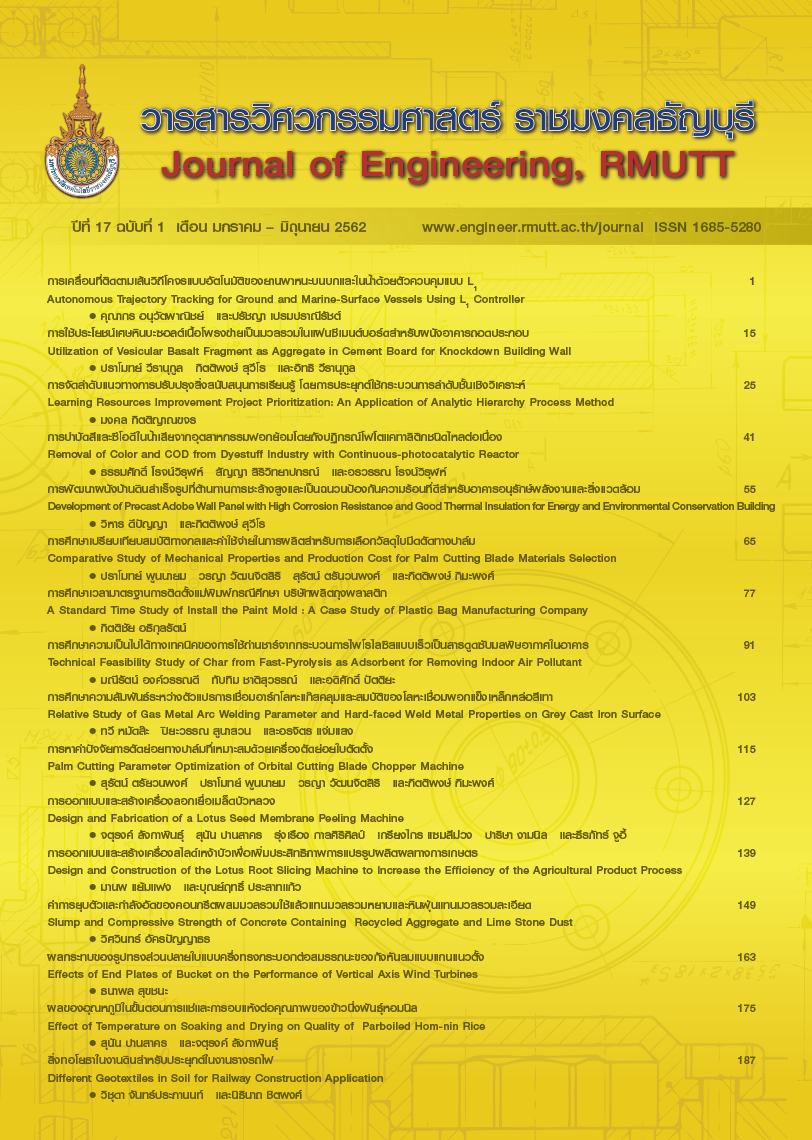ผลของอุณหภูมิในขั้นตอนการแช่และการอบแห้งต่อคุณภาพของ ข้าวนึ่งพันธุ์หอมนิล
Main Article Content
บทคัดย่อ
งานวิจัยนี้มีวัตถุประสงค์ในการศึกษาผลของอุณหภูมิ (30,40oC) ในขั้นตอนการแช่เมล็ดข้าวในน้ำ และอุณหภูมิ (40, 80oC) ในขั้นตอนการอบแห้ง ต่อคุณภาพข้าวนึ่งพันธุ์หอมนิล ได้แก่ ค่าสี (L*,a*,b*) ค่าความแตกต่างของสีโดยรวม (DE*) ค่าความชื้น ค่าปริมาณน้ำอิสระ และค่าปริมาณสารแอนโทไซยานิน ผลการวิจัยพบว่า ค่าสี L*a* b* ของเมล็ดข้าวหอมนิลก่อนและหลังกระบวนการผลิตข้าวนึ่ง ไม่มีความแตกต่างอย่างมีนัยสำคัญทางสถิติ (P>0.05) แต่เมื่อเปรียบเทียบค่าความแตกต่างของสีโดยรวมระหว่างค่าสีของเมล็ดข้าวหอมนิลก่อนและหลังการผลิตข้าวนึ่ง พบแนวโน้มการลดลงเมื่อเพิ่มอุณหภูมิในการแช่เมล็ดข้าวหอมนิลจาก 30oC เป็น 40oC ที่เวลา 4 hr และการอบแห้งข้าวหอมนิลนึ่งด้วยอุณหภูมิ 40oC และ 80oC ทั้งนี้จากการลดความชื้นของเมล็ดข้าวหอมนิลนึ่ง ให้ค่าปริมาณความชื้นระหว่าง 11.33-13.57%wb. และค่าวอเตอร์แอคติวิตี้ (aw) ระหว่าง 0.5-0.6 ซึ่งอยู่ในเกณฑ์ที่เหมาะสำหรับผลิตภัณฑ์อาหารแห้งเนื่องจากช่วยยืดอายุการเก็บรักษา นอกจากนี้เมื่อตรวจสอบปริมาณสารแอนโทไซยานิน พบว่าข้าวหอมนิลก่อนผ่านกระบวนการนึ่งมีค่า 5.11 mg/g dry weight และคงเหลือระหว่าง 3.03-4.33 mg/g dry weight เมื่อเมล็ดข้าวหอมนิลผ่านการแช่ในน้ำที่อุณหภูมิเพิ่มสูงขึ้น ร่วมกับการลดความชื้นด้วยการอบแห้งที่อุณหภูมิสูงขึ้น อย่างไรก็ตามกระบวนการผลิตข้าวนึ่งเป็นการปรับปรุงคุณภาพข้าวและช่วยให้สามารถเก็บรักษาได้ยาวนานขึ้นกว่าการเก็บในรูปของข้าวกล้องหอมนิล
Article Details
บทความ ข้อมูล เนื้อหา รูปภาพ ฯลฯ ที่ได้รับการตีพิมพ์ในวารสารแนวหน้าวิจัยนวัตกรรมทางวิศวกรรม ถือเป็นลิขสิทธิ์ของวารสารฯ เท่านั้น ไม่อนุญาติให้บุคคลหรือหน่วยงานใดคัดลอกเนื้อหาทั้งหมดหรือส่วนหนึ่งส่วนใดไปเผยแพร่เพื่อกระทำการใด ๆ ที่ไม่ถูกต้องตามหลักจริยธรรม
เอกสารอ้างอิง
Leethanapanich K, Mauromoustakos A, Y.J. Wang Y.J. Impacts of parboiling conditions on quality characteristics of parboiled commingled rice. Journal of Cereal Science. 2016; 69: 283–289.
Paiva F. F, Vanier N. L. V, Berrios J. J, Pinto V. Z, Wood D, Williams T. Elias M.C. Polishing and parboiling effect on the nutritional and technological properties of pigmented rice. Food Chemistry. 2016; 191: 105–112.
Sarangapani C, Thirumdas R, Devi Y, Trimukhe A, Deshmukh R. R, Annapure U.S. Effect of low-pressure plasma on physicoechemical and functional properties of parboiled rice flour. LWT - Food Science and Technology. 2016; 69: 482–489.
Bhattacharya K. R. Parboiling of rice. In E. T. Champagne (Ed.), Rice: Chemistry and technology. St. Paul, MN, USA: American Association of Cereal Chemists; 2004. p. 289-348.
Delcour, J. A. Hoseney R.C. Rice and oat processing. Principles of Cereal Science and Technology. St. Paul, MN, USA: AACC International; 2010. p. 149-160.
Buggenhout J, Brijs K, Celus I, Delcour J.A. The breakage susceptibility of raw and parboiled rice: a review. Journal of Food Engineering. 2013; 117: 304-315.
Kar N, Jain R.K, Srivastaya P.P. Parboiling of de husked rice. Journal of Food Engineering. 1999; 39(1): 17-22.
Soponronnarit S, Nathakaranakule A, Jirajindalert A, Taechapairoj C. Parboiling brown rice using superheated steam fluidization technique. 2006; Journal of Food Engineering. 2006; 75(3): 423-432.
Parnsakhorn S, Noomhorm A. Changes in Physicochemical Properties of Parboiled Brown Rice during Heat Treatment. Agricultural Engineering International: the CIGR E-journal. Manuscript FP 08 009. Vol. X. 2008.
Buggenhout J, Brijs K, Oevelen J.V, Delcour J.A. Milling breakage susceptibility and mechanical properties of parboiled brown rice kernels. Food Science and Technology. 2014; 59(1): 369-375.
Laze M.C, Savio M, Pizzala R, Cazzalini O, Perucca P, Scovassi A.I, Stivala L.A, Bianchi L. Anthocyanins induce cell cycle perturbations and apoptosis in different human celllines. Carcinogenesis. 2004; 25(8): 1427-1433.
AOAC. Official Methods of Analyses of the Association of Official Analytical Chemists. 15th ed. Association of Official Analytical Chemists. 1990.
Rhim R. V, Nunes V. A, Jones K, Swartzel R. Kinetics of color change of grape juice generated using linearly increasing temperature. Journal of Food Science. 1989; 54(3): 776–777.
Suwan N. Effect of coating materials on controlling of browning and weight loss in lychee fruit. Master of Science in Biology. Chiang Mai University. 2005. (in Thai)
Ranganna S. Plant pigment. In S. Ragana (ed.). Manual of analysis of fruit and vegetable produce. Tata McGraw-Hill Publishing Co., Ltd, New Delhi; 1977. p. 72-93.
Sompong R, Siebenhandl-Ehn S, Linsberger-Martin G. Berhhofer E. Physicochemical and antioxidative properties of red and black rice varieties from Thailand, China and Srilanka. Food Chemistry. 2011; 124(1): 132-140.
Lee J.C, Kim J.D, Hsieh F.H, Eun J.B. Production of black rice cake using ground black rice and medium-grain brown rice. International Journal of Food Science and Technology. 2008; 43(6): 1078-1082.
Singhasurasak H, Rice berry. 2014 [cited 2014 May 25]. Available from: http://riceberry- rice.blogspot.com/2013/12/blog-post.html. (in Thai)
Pillaiyar P, Mohandas R. Hardness and color in parboiled rice produced at low and high temperature. Journal of Food Science and Technology. 1981; 18: 7-9.
Kimura T, Bhattacharya K.R, Ali S.Z. Discoloration characteristics of rice during parboiling (I): Effect of processing conditions on the color intensity of parboiled rice. Journal of the Society of Agricultural Structures. 1993; 24(2): 23–30.
Parnsakhorn S. Thermal process. 2nd ed. Bangkok: Triple Education Co., Ltd.; 2017. (in Thai)
Das A, Das S, Subudhi H, Mishra P, Sharma S. Extension of shelf life of brown rice with some traditionally available materials. Indian Journal of Traditional Knowledge. 2012; 11(3): 553-555.
Parnsakhorn S. Thermal process. 2nd ed. Bangkok: Triple Education Co., Ltd.; 2017.
Rungsardthong V. Food processing technology. 5th ed. Bangkok: Text and Journal Publication Co., Ltd.; 2014. (in Thai)
Markakis P. Anthocyanins as food colors. New York : Academic Press. 1982.


